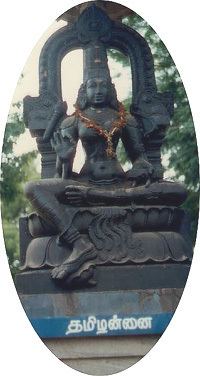 | ||
Tamil Thai (Tamil: தமிழ்த்தாய், Tamiḻ Tāy, Tamizh Thai) denotes the deified personification of the Tamil language as a mother. This deification of Tamil language in the persona of a mother got established during the Tamil renaissance movement of the later half of the nineteenth century. The phrase became popular in the Tamil speaking world after the publication of a song invoking and praising Tamil mother in a play titled "Manonmaniyam" written by Manonmaniam Sundaram Pillai (1855 – 1897) and published in 1891. The song with music composed by M.S. Viswanathan has since been adopted as the state song of Government of Tamil Nadu.
Contents
Temple for Tamil mother
Tamil Thai Kovil is a temple in which the presiding deity is Tamil Thai representing Tamil language. This temple, located in Karaikudi in Sivaganga district in Tamil Nadu, is the only temple in the world for worshiping a language as a god or goddess. The temple is situated inside the Kamban Mani Mandabam and the street in which the temple is located has been named Tamil Thai Kovil Street.
The idea of establishing such a temple was conceived by Kamban Adippodi Saw. Ganesan the founder of Kamban Vizha Kazhagam. The Tamil Thai temple was declared open in 1993, by Mu. Karunanidhi. The main shrine is for Tamil Thai. On either side of the idol of Tamil Thai, there are smaller idols of Agastyar and Tholkappiyar. Outside the main shrine are icons of Oli Thai (the Goddess of Sound) and Vari Thai (the Goddess of Letters). There are separate enclosures for Kamban, Ilango Adigal and Thiruvalluvar. V. Ganapati Sthapati, temple architect and builder from Karaikudi, designed, constructed and did the sculpturing work of the temple.
The idol of Tamil Thai installed in the temple is not worshiped in the same way as the idols installed in other temples. The Tamil Thai temple remains closed except during the Kamban Vizha which happens during the month of April every year.
Statue of Tamil Thai in Madurai
In 1981, the then Tamil Nadu Government under M. G. Ramachandran had declared open a Tamil Thai statue in Madurai on the occasion of the Fifth World Tamil Conference in January 1981.
On 14 May 2013, J. Jayalalithaa, Chief Minister of Tamil Nadu, announced in the State Legislative Assembly that an over 300-feet high statue of Tamilththaai (தமிழ்த்தாய்) would be installed in Madurai at an approximate cost of Rs.100 crore. She also announced that the statue would be on the lines of the Statue of Liberty in New York City. The image of the proposed statue has also attracted some criticism for the likely implications of the underlying iconographic presuppositions.
Visual representations of Tamil Thai
The goddess of Tamil Thai has been depicted variously in different media. Since the coinage of the concept and terminology of Tamil Thai by Manonmaniam Sundaram Pillai, the persona of Tamil Thai has been presented in a variety of ways in the print media via books, posters, paintings, in textbook illustrations, advertisements and cartoons. Statues of Tamil Thai have benn imagined and sculpted in several different forms. For example, in 1940, as directed by Ganesan, Vaidyanatha Stapathi created a panchaloha idol of Tamil Thai depicting Tamil Thai as seated on a globe to indicate the geographical spread of Tamil. In this statue, Tamil Thai holds in her hands palm leaf manuscripts, a japa mala, the torch of knowledge and a Sengottu yazh. The statue installed to commemorate the Fifth International Tamil Conference, Madurai, 1981, depicts Tamil Thai in a seated position sitting on a lotus flower with one hand in the abhayamudra. A nearly identical statue has been installed as the main idol in the Tamil Thai Temple in Karaikudi. The statue proposed to be installed at Madurai represents Tamil Thai in a standing position.
